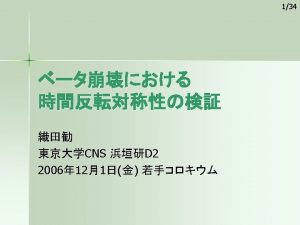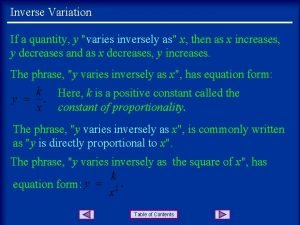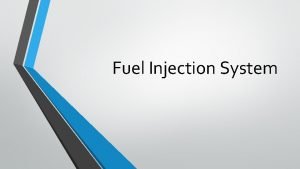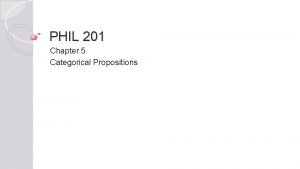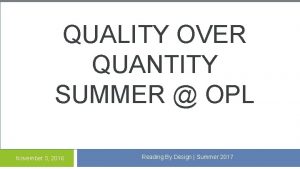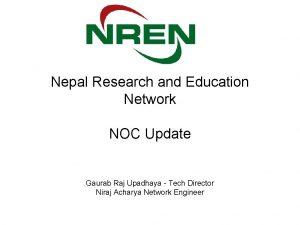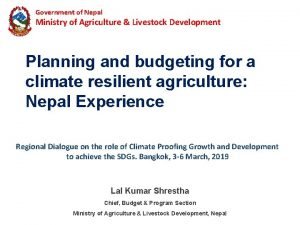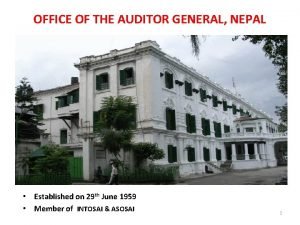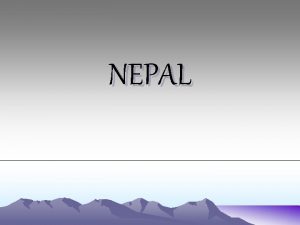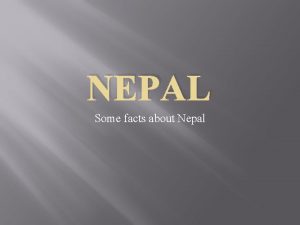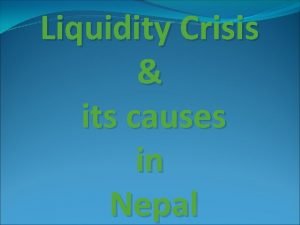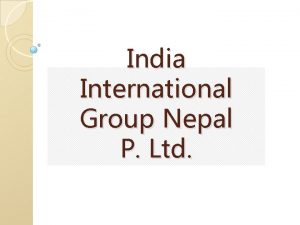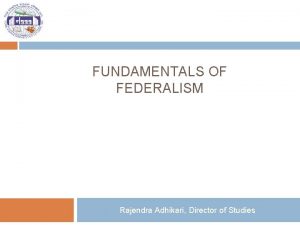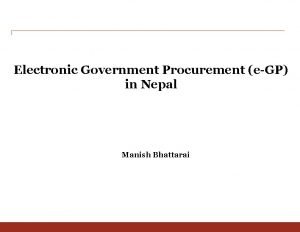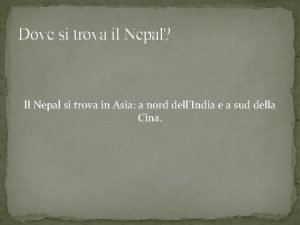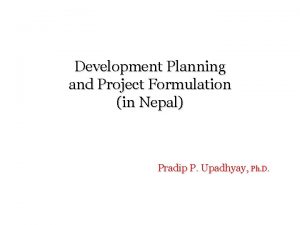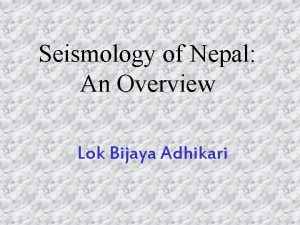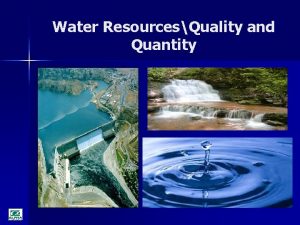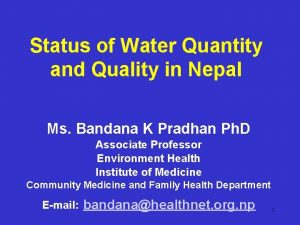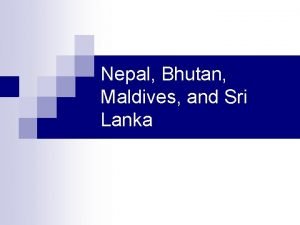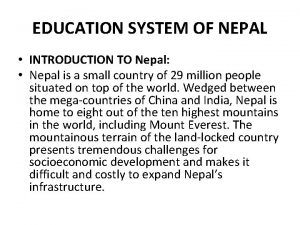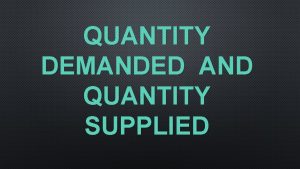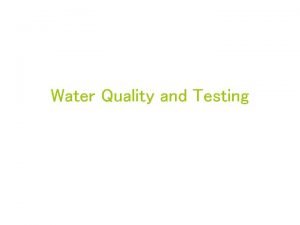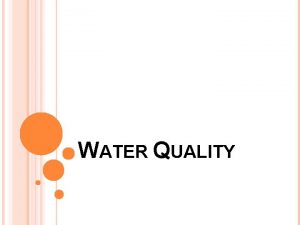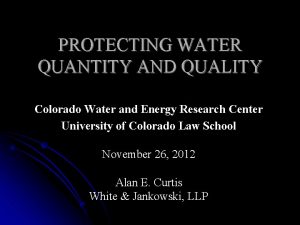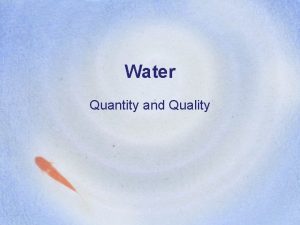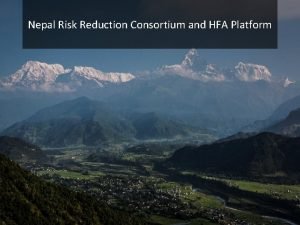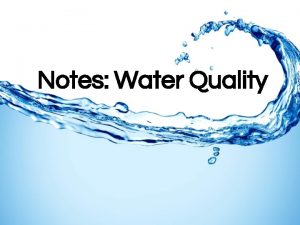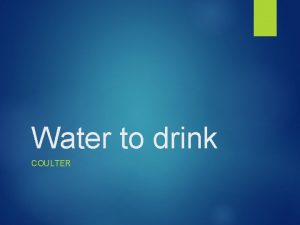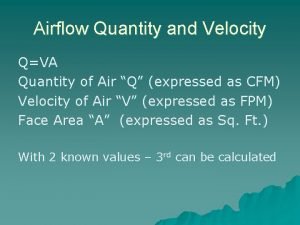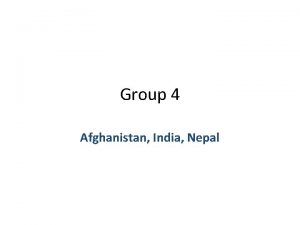Status of Water Quantity and Quality in Nepal





































- Slides: 37

Status of Water Quantity and Quality in Nepal Ms. Bandana K Pradhan Ph. D Associate Professor Environment Health Institute of Medicine Community Medicine and Family Health Department E-mail: bandana@healthnet. org. np 1

Geographical Division of Nepal (Meter) (65 - 1000) (1000 -4000) (4000 -8848 ) 2

Rainfall Mean annual rainfall 1, 700 mm, 75% of which occur during monsoon season Surface Water Over 6, 000 rivers, make up 54% of the total water coverage · 660 Lakes with >1 ha · Renewable Water 224 billion m 3/Y Mean Monsoon Rainfall 3

General Rainfall and Discharge Pattern in Nepal 4

PRESSURE QUANTITY Pressures • Population • Urbanisation • Industry • Land use change • Poor maintenance Resources QUALITY • Waste water • Solid waste • Agro-chemicals Information Social response Analysis Pressure-State-Impact. Response (P-S-I-R) Analytical Framework STATE • Surface water • Groundwater • Water demand • Water supply • Water coverage • Water quality Social response • Policies RESPONSE • Programmes • Acts & Regulations • Implemented activities • Conventions & treaties • Resource allocation • Institution organisation Information 5

Pressure • Rapid growth of population (2. 3 % per year) • Rapid urbanisation • Increment of industries • Expansion of agricultural infrastructure: irrigation • Poor maintenance of water reserviours, irrigation canals, water pipelines, etc 6

Pressure for the Deterioration of Water Quality Domestic Wastewater Solid Waste Industrial Waste Man-made Natural Disasters Contamination of Water Bodies Increase in use of Agrochemicals Land Use Change 7

Status - Total Water Availability and Its Use in Nepal 1991 2001 Description Total annual surface water availability (km 3/y)* Per capita surface water resource (000 m 3/y) Total annual withdrawal (km 3/y) Per capita withdrawal (000 m 3/y) 224 12. 1 12. 95 0. 71 9. 6 17. 1 0. 73 Sectoral withdrawal as % of total water withdrawal Domestic 3. 97 3. 2 Industry Agriculture 0. 34 0. 26 95. 68 96. 54 8

Status - Kathmandu Valley • Almost All Major Rivers at Source have been tapped for Drinking Water Purpose • Supply of Drinking Water 115 Million Liters/Day • Estimated Daily Demand: 145 Million Liters (in 2000) Meeting 79% of the total Urban Population Demand 9

Status - Ground Water Tarai Region Owns 12 Billion Meters 3 (km 3) Annual Potential Extraction 5. 8 to 9. 6 Billion Meters 3 Current Withdrawal 0. 52 Billion Meters 3/Year Kathmandu Valley Total Sustainable Withdrawal 26. 3 MLD Current Extraction 58. 6 MLD Over-Exploitation >60% MLD = million liter per day 10

Domestic Waste • Non-Existent of Sewerage Network System in all Towns Except Kathmandu Valley Towns • Only 15% of the Total Houses in Kathmandu Valley Towns Accessed to Sewerage Facility • All Domestic Wastewater and Sewers Discharged Directly into the Rivers without Treatment • Recorded an Average of 20, 846 Kg BOD/Day for the Bagmati River at the Outlet, Constituted 42% of the Total BOD Load Produced by the Valley’s People • Total Industrial BOD Load Discharged Directly 11 into the River: 3, 151 Kg/Day

Industrial pollution Load in Nepal and the Kathmandu Valley Pollution indicators/year Waste water volume (million m 3) Kathmandu Valley Country 2. 1 8. 56 BOD (000 tonnes) 1. 15 5. 74 1. 41 9. 59 TSS ( 000 tonnes) BOD = Biological oxygen demand, TSS = total suspended solid 12

Major Industrial BOD load going into 13 the surface water

Increase in Use of Agro-Chemicals • Average Use Of Chemical Fertilizers (NPK)/Hectare Increased from 7. 6 Kg in 1975 to 26. 6 Kg in 2000 • Use of Fertilisers Estimated to be 420 Kg/Ha in Chitwan District • Altogether 250 Types of Pesticides Used • Average Pesticide Used 0. 17 Kg/Hectare in 1986 • Pesticide at the Range of 34– 100 ppb in the Samples Detected in the Fish Flesh and Plankton 14 in Three Lakes of the Pokhara Valley, West Nepal

Change in Land Use Pattern • Agricultural Land Increased from 1592, 000 to 2968, 000 Ha between 1975 and 2000 • Forest Area Declined from 5617, 000 to 4269, 000 Ha between 1977 and 2000 • Urban Built-Up Area in Kathmandu Valley Increased From 26% to 46. 2% between 1978 and 2000 • Rural Built-Up Areas Increased From 11. 2% to 15 24%

STATE Total Water Quantity Available in Nepal • Total Available Surface 224 Billions m 3 • Groundwater Potentials 8. 8 Billions m 3 • Total Water Demand (Domestic, Industry & Commerce) Estimated To Be 1239. 7 Million Litres Per Day For 2000 16

Status - Urban Water Supply 17

State The Water Quality Classification of the Bagmati River –Example of Anthropogenic intervention The poorest quality in the valley basin where population density is the highest 18

Bagmati River in the Kathmandu Valley Near Holy Temple Pashupati Nath 19

Status - Ground Water Quality of Tarai Region Most of the water samples from tube wells are contaminated with coliform bacteria. 20

More than 90% people consume water from ground water in the Tarai Region The degree of Arsenic contamination varies in Tarai 21 region but the whole region is at risk zone

Water Use and Waste Water Discharged into near by River by Carpet Industry 22

Disturbance of river ecology due to sand quarrying activity in the Manohara river, 23 Kathmandu Valley

Water Quality Deterioration due to Relative Volume of Waste Water Discharged into near by River · Domestic waste · Industrial waste 24

River Water (Polluted ) Collected for Drinking Purpose 25

26

The trend of water quality deterioration in the Bagmati River of the Kathmandu valley 27

Water Quality Status from Different Sources in Kathmandu All the water sources of Kathmandu valley are 28 faecally contaminated in different degree

Impact The so called potable water is not safe, Incidence of diarrhoeal disease does not show any relationship with the increment of 29 access of water supply

Water Quality and Diarrhoeal Disease Impact 30

Impact (contd. ) For the prevention of diarrhoeal disease curative aspect is only given priority 31

Responses Most of the industries directly discharge their effluent into river. Few industries have treatment plants with primary treatment system as shown in table below 32

Responses (Contd. . ) Wastewater Management Efforts in Kathmandu 33

Response - Acts and Regulation • Solid Waste Act 1987 • Solid Waste Regulations 1989 • Industrial Enterprises Act 1992 • Electricity Act 1992 • Water Resources Regulations 1993 • National Policy on Sanitation - 1994, • Environmental Protection Act 1996 • National Water Supply Sector Policy -1998 • The Bagmati Sector Sewerage Construction/Improvement Project 34

GAPS • A wide gap of data on water quality and quantity for all parts of the country • Inadequacy in regular monitoring of water quality • No lead agency to take on water quality management and coordination among the water organizations at national level • Lack of central data bank on water quality • No water quality standard for all types of industrial effluents • Lack of commitment in implementing the water quality control measures. • Lack of effective awareness programmes at local 35 level about the conservation of water sources.

Recommendation · Urgently require efforts for maintaining drinking water pipeline & controlling open defecation · Provision of potable water to mass general people · Urgently set up a lead agency for coordinating water-related organisations · Initiate water quality monitoring program at national level · Harvesting of rainwater in major urban areas · Effective awareness activities towards conserving water quality &quantity · Recycling of domestic wastewater (Grey water) · Minimise leakage of piped drinking water · More action oriented research activities on water 36 quality and quantity

37
 Water and water and water water
Water and water and water water Examples of scalar
Examples of scalar Scalar and vector quantities
Scalar and vector quantities Scalar distance
Scalar distance Scalar quantity
Scalar quantity Quantity y varies inversely as quantity x.
Quantity y varies inversely as quantity x. Difference between quality and quantity
Difference between quality and quantity Aristotelian standpoint
Aristotelian standpoint B. quality vs quantity
B. quality vs quantity Quality quantity
Quality quantity Quality over quantity
Quality over quantity Right time right place right quantity right quality
Right time right place right quantity right quality Quantity water
Quantity water Quality assurance vs quality control
Quality assurance vs quality control Basic concepts of quality control
Basic concepts of quality control Chapter 25 human geography of south asia
Chapter 25 human geography of south asia Nepal research and education network
Nepal research and education network Ministry of agriculture and livestock development nepal
Ministry of agriculture and livestock development nepal Quality control vs quality assurance pmp
Quality control vs quality assurance pmp Pmp gold plating
Pmp gold plating Process of nursing audit
Process of nursing audit Quality improvement vs quality assurance
Quality improvement vs quality assurance Quality gurus and their contribution
Quality gurus and their contribution Crosby's fourteen steps to quality improvement
Crosby's fourteen steps to quality improvement Old quality vs new quality
Old quality vs new quality Oag nepal
Oag nepal Zastava nepala
Zastava nepala Facts about nepal flag
Facts about nepal flag Ymca nepal
Ymca nepal Causes of liquidity crisis in nepal
Causes of liquidity crisis in nepal Iig nepal
Iig nepal Pembentukan gunung lipat
Pembentukan gunung lipat यगत
यगत Ppmis
Ppmis Dove si trova il nepal
Dove si trova il nepal Process of plan formulation in nepal
Process of plan formulation in nepal Palliative care in nepal
Palliative care in nepal Seismology nepal
Seismology nepal




